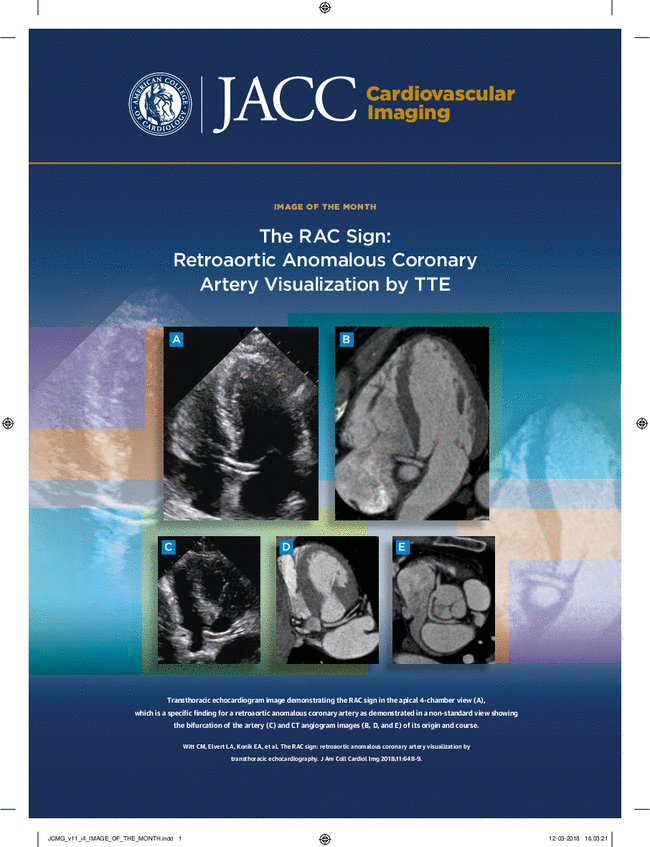Impact of Right Ventricular Pressure Overload on Myocardial Stiffness Assessed by Natural Wave Imaging
IF 12.8
1区 医学
Q1 CARDIAC & CARDIOVASCULAR SYSTEMS
引用次数: 0
Abstract
Background
Right ventricular (RV) hemodynamic performance determines the prognosis of patients with RV pressure overload. Using ultrafast ultrasound, natural wave velocity (NWV) induced by cardiac valve closure was proposed as a new surrogate to quantify myocardial stiffness.
Objectives
This study aimed to assess RV NWV in rodent models and children with RV pressure overload vs control subjects and to correlate NWV with RV hemodynamic parameters.
Methods
Six-week-old rats were randomized to pulmonary artery banding (n = 6), Sugen hypoxia-induced pulmonary arterial hypertension (n = 7), or sham (n = 6) groups. They underwent natural wave imaging, echocardiography, and hemodynamic assessment at baseline and 6 weeks postoperatively. The authors analyzed NWV after tricuspid and after pulmonary valve closure (TVC and PVC, respectively). Conductance catheters were used to generate pressure-volume loops. In parallel, the authors prospectively recruited 14 children (7 RV pressure overload; 7 age-matched control subjects) and compared RV NWV with echocardiographic and invasive hemodynamic parameters.
Results
NWV significantly increased in RV pressure overload rat models (4.99 ± 0.27 m/s after TVC and 5.03 ± 0.32 m/s after PVC in pulmonary artery banding at 6 weeks; 4.89 ± 0.26 m/s after TVC and 4.84 ± 0.30 m/s after PVC in Sugen hypoxia at 6 weeks) compared with control subjects (2.83 ± 0.15 m/s after TVC and 2.72 ± 0.34 m/s after PVC). NWV after TVC correlated with both systolic and diastolic parameters including RV dP/dtmax (r = 0.75; P < 0.005) and RV Ees (r = 0.81; P < 0.005). NWV after PVC correlated with both diastolic and systolic parameters and notably with RV end-diastolic pressure (r = 0.65; P < 0.01). In children, NWV after both right valves closure in RV pressure overload were higher than in healthy volunteers (P < 0.01). NWV after PVC correlated with RV E/E' (r = 0.81; P = 0.008) and with RV chamber stiffness (r = 0.97; P = 0.03).
Conclusions
Both RV early-systolic and early-diastolic myocardial stiffness show significant increase in response to pressure overload. Based on physiology and our observations, early-systolic myocardial stiffness may reflect contractility, whereas early-diastolic myocardial stiffness might be indicative of diastolic function.
通过自然波成像评估右心室压力超负荷对心肌僵硬度的影响
背景:右心室(RV)的血流动力学表现决定了右心室压力超负荷患者的预后。利用超快超声波,由心脏瓣膜关闭引起的自然波速度(NWV)被认为是量化心肌僵硬度的新替代物:本研究旨在评估啮齿类动物模型和儿童 RV 压力超负荷与对照组的 RV 自然波速度,并将自然波速度与 RV 血流动力学参数相关联:方法:将六周大的大鼠随机分为肺动脉束带组(n = 6)、Sugen缺氧诱导的肺动脉高压组(n = 7)或假体组(n = 6)。它们在基线和术后 6 周接受了自然波成像、超声心动图和血液动力学评估。作者分析了三尖瓣关闭后和肺动脉瓣关闭后的自然波(分别为 TVC 和 PVC)。电导导管用于生成压力-容积环路。同时,作者前瞻性地招募了14名儿童(7名RV压力超负荷;7名年龄匹配的对照组),并将RV NWV与超声心动图和有创血流动力学参数进行了比较:与对照受试者(TVC后为2.83±0.15 m/s,PVC后为2.72±0.34 m/s)相比,RV压力过载大鼠模型的NWV明显增加(肺动脉绑扎6周时,TVC后为4.99±0.27 m/s,PVC后为5.03±0.32 m/s;Sugen缺氧6周时,TVC后为4.89±0.26 m/s,PVC后为4.84±0.30 m/s)。TVC 后的 NWV 与收缩和舒张参数相关,包括 RV dP/dtmax (r = 0.75; P < 0.005) 和 RV Ees (r = 0.81; P < 0.005)。PVC 后的 NWV 与舒张和收缩参数相关,尤其与 RV 舒张末压相关(r = 0.65;P < 0.01)。在儿童中,右心室压力超负荷时两个右瓣膜关闭后的NWV高于健康志愿者(P < 0.01)。PVC 后的 NWV 与 RV E/E' 相关(r = 0.81;P = 0.008),与 RV 腔硬度相关(r = 0.97;P = 0.03):结论:RV 收缩早期和舒张早期心肌僵硬度在压力超负荷时都会显著增加。根据生理学和我们的观察,早期收缩期心肌僵硬度可能反映收缩能力,而早期舒张期心肌僵硬度可能反映舒张功能。
本文章由计算机程序翻译,如有差异,请以英文原文为准。
求助全文
约1分钟内获得全文
求助全文
来源期刊

JACC. Cardiovascular imaging
CARDIAC & CARDIOVASCULAR SYSTEMS-RADIOLOGY, NUCLEAR MEDICINE & MEDICAL IMAGING
CiteScore
24.90
自引率
5.70%
发文量
330
审稿时长
4-8 weeks
期刊介绍:
JACC: Cardiovascular Imaging, part of the prestigious Journal of the American College of Cardiology (JACC) family, offers readers a comprehensive perspective on all aspects of cardiovascular imaging. This specialist journal covers original clinical research on both non-invasive and invasive imaging techniques, including echocardiography, CT, CMR, nuclear, optical imaging, and cine-angiography.
JACC. Cardiovascular imaging highlights advances in basic science and molecular imaging that are expected to significantly impact clinical practice in the next decade. This influence encompasses improvements in diagnostic performance, enhanced understanding of the pathogenetic basis of diseases, and advancements in therapy.
In addition to cutting-edge research,the content of JACC: Cardiovascular Imaging emphasizes practical aspects for the practicing cardiologist, including advocacy and practice management.The journal also features state-of-the-art reviews, ensuring a well-rounded and insightful resource for professionals in the field of cardiovascular imaging.
 求助内容:
求助内容: 应助结果提醒方式:
应助结果提醒方式:


